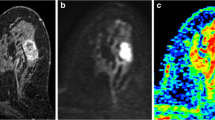Abstract
Purpose
This study aims to comprehensively evaluate the diagnostic value of quantitative parameters extracted from apparent diffusion coefficient (ADC) maps in distinguishing fibroepithelial tumors using whole-tumor histogram and texture analysis.
Materials and methods
This retrospective study included 66 female patients with single phyllodes tumor (PT) and 29 female patients with single fibroadenoma (FA) who underwent preoperative magnetic resonance imaging. By independently performing whole-tumor histogram and texture analysis based on ADC maps, two radiologists extracted seven histogram parameters and four texture parameters. The extracted parameters were compared using univariate analysis to determine their ability to distinguish FAs from PTs, benign PTs from FAs, as well as benign PTs from borderline and malignant PTs.
Results
When FAs and PTs were compared, ADC_skewness values of PTs were significantly lower than those of FAs (p < 0.05), whereas other significant extracted parameter values of PTs were significantly higher than those of FAs (p ≤ 0.001); the area under the curve of significant parameters combined was 0.936. Regarding the differences between FAs and benign PTs, ADC_SD, ADC_95th percentile and ADC_kurtosis of FAs were significantly lower than those of benign PT group, and ADC_skewness was higher than that of benign PT group (all p < 0.05). Furthermore, ADC_SD, ADC_95th percentile and all texture parameters are significantly higher in the borderline and malignant PT group than in FA and benign PT group (p < 0.05). In addition, ADC_kurtosis of malignant PT group was significantly lower than that of borderline PT group (p = 0.045).
Conclusion
The extracted whole-tumor histogram and texture features of ADC maps can improve differential diagnosis of breast fibroepithelial tumors and contribute to optimal selection for clinical management of patients with fibroepithelial tumors.



Similar content being viewed by others
References
Li JJX, Tse GM. Core needle biopsy diagnosis of fibroepithelial lesions of the breast: a diagnostic challenge. Pathology. 2020;52(6):627–34. https://doi.org/10.1016/j.pathol.2020.06.005.
Tan PH. Fibroepithelial lesions revisited: implications for diagnosis and management. Mod Pathol. 2021;34(Suppl 1):15–37. https://doi.org/10.1038/s41379-020-0583-3.
Tumours. WCoTIB. Classification of Tumours. In: Breast tumours. 2019.
Tan BY, Tan PH. A diagnostic approach to fibroepithelial breast lesions. Surg Pathol Clin. 2018;11(1):17–42. https://doi.org/10.1016/j.path.2017.09.003.
Di Liso E, Bottosso M, Lo Mele M, et al. Prognostic factors in phyllodes tumours of the breast: retrospective study on 166 consecutive cases. ESMO Open. 2020;5(5):e000843. https://doi.org/10.1136/esmoopen-2020-000843.
Yabuuchi H, Soeda H, Matsuo Y, et al. Phyllodes tumor of the breast: correlation between MR findings and histologic grade. Radiology. 2006;241(3):702–9.
Mangi AA, Smith BL, Gadd MA, Tanabe KK, Ott MJ, Souba WW. Surgical management of phyllodes tumors. Arch Surg. 1999;134(5):487–92.
Liew KW, Siti Zubaidah S, Doreen L. Malignant phyllodes tumors of the breast: A single institution experience. Med J Malaysia. 2018;73(5):297–300.
Kamitani T, Matsuo Y, Yabuuchi H, et al. Differentiation between benign phyllodes tumors and fibroadenomas of the breast on MR imaging. Eur J Radiol. 2014;83(8):1344–9. https://doi.org/10.1016/j.ejrad.2014.04.031.
Mai H, Mao Y, Dong T, et al. The utility of texture analysis based on breast magnetic resonance imaging in differentiating phyllodes tumors from fibroadenomas. Front Oncol. 2019;9:1021. https://doi.org/10.3389/fonc.2019.01021.
Li X, Jiang N, Zhang C, Luo X, Zhong P, Fang J. Value of conventional magnetic resonance imaging texture analysis in the differential diagnosis of benign and borderline/malignant phyllodes tumors of the breast. Cancer Imaging. 2021;21(1):29. https://doi.org/10.1186/s40644-021-00398-3.
Guo Y, Tang W-J, Kong Q-C, et al. Can whole-tumor apparent diffusion coefficient histogram analysis be helpful to evaluate breast phyllode tumor grades? Eur J Radiol. 2019;114:25–31. https://doi.org/10.1016/j.ejrad.2019.02.035.
Xie T, Zhao Q, Fu C, et al. Differentiation of triple-negative breast cancer from other subtypes through whole-tumor histogram analysis on multiparametric MR imaging. Eur Radiol. 2019;29(5):2535–44. https://doi.org/10.1007/s00330-018-5804-5.
Sun K, Zhu H, Chai W, et al. Whole-lesion histogram and texture analyses of breast lesions on inline quantitative DCE mapping with CAIPIRINHA-Dixon-TWIST-VIBE. Eur Radiol. 2020;30(1):57–65. https://doi.org/10.1007/s00330-019-06365-8.
Ditsatham C, Chongruksut W. Phyllodes tumor of the breast: diagnosis, management and outcome during a 10-year experience. Cancer Manag Res. 2019;11:7805–11. https://doi.org/10.2147/CMAR.S215039.
Lu Y, Chen Y, Zhu L, et al. local recurrence of benign, borderline, and malignant phyllodes tumors of the breast: a systematic review and meta-analysis. Ann Surg Oncol. 2019;26(5):1263–75. https://doi.org/10.1245/s10434-018-07134-5.
Zhang L, Yang C, Pfeifer JD, et al. Histopathologic, immunophenotypic, and proteomics characteristics of low-grade phyllodes tumor and fibroadenoma: more similarities than differences. NPJ Breast Cancer. 2020;6:27. https://doi.org/10.1038/s41523-020-0169-8.
Barth RJ. Borderline and malignant phyllodes tumors: how often do they locally recur and is there anything we can do about it? Ann Surg Oncol. 2019;26(7):1973–5. https://doi.org/10.1245/s10434-019-07278-y.
Parsian S, Giannakopoulos NV, Rahbar H, Rendi MH, Chai X, Partridge SC. Diffusion-weighted imaging reflects variable cellularity and stromal density present in breast fibroadenomas. Clin Imaging. 2016;40(5):1047–54. https://doi.org/10.1016/j.clinimag.2016.06.002.
Acknowledgements
No applicable.
Author information
Authors and Affiliations
Corresponding author
Ethics declarations
Funding
There was no funding obtained for this retrospective analysis.
Conflict of interest
The authors declare that they have no competing interests.
Additional information
Publisher's Note
Springer Nature remains neutral with regard to jurisdictional claims in published maps and institutional affiliations.
About this article
Cite this article
Li, X., Chai, W., Sun, K. et al. The value of whole-tumor histogram and texture analysis based on apparent diffusion coefficient (ADC) maps for the discrimination of breast fibroepithelial lesions: corresponds to clinical management decisions. Jpn J Radiol 40, 1263–1271 (2022). https://doi.org/10.1007/s11604-022-01304-y
Received:
Accepted:
Published:
Issue Date:
DOI: https://doi.org/10.1007/s11604-022-01304-y




